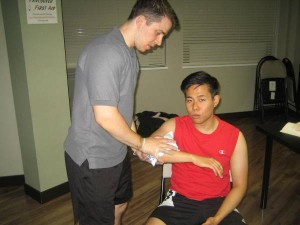Open wounds can compromise the health of a person. It can lead to health problems such as infection and loss of blood due to bleeding. Therefore, it is important that you are able to provide immediate, proper first aid treatment to avoid potential health problems. Here are the general principles of emergency care for open wounds. When providing first aid for open wounds, make sure you avoid direct contact with blood and other body fluids of the person.
Important Disclaimer: The information posted on this page on first aid treatment for open wounds is for learning purposes only. Enrol in workplace approved first aid and CPR classes to learn to recognize and manage bleeding emergencies (find a course here).
1. Expose the wound
Gently lift up, split away, or cut any clothing or sheets that cover the wound. This is best done using scissors, if available. Do not attempt removing the clothing in the usual way. It can only aggravate the injuries and further cause harm and pain.
2. Clear the wound surface
Carefully remove obvious foreign objects from the surface of the wound, however, do not clean the wound or waste your time picking debris and particles embedded in the wound. Proper wound cleaning is best done in a healthcare facility by a physician. If possible, use a sterile dressing to brush away foreign material from the wound. Avoid contaminating the wound with your hands or unclean surface.
3. Control bleeding
Apply direct pressure over the wound and elevate affected part. Use a sterile dressing or clean sheet to cover the wound then apply pressure. Tourniquet is not recommended for controlling bleeding but may be used in cases of severe bleeding.
4. Prevent infection and further contamination
If possible, use sterile dressing. If it is not available look for the cleanest piece of cloth or improvise on available resources.
5. Apply bandage after bleeding has been controlled
If the injury involves an extremity, be sure to check the distal pulse to make certain that the bandage does not constrict the blood vessels and interrupt the blood circulation to the distal parts of the extremity. As much as possible, dressing should be applied once bleeding has been controlled. Periodically recheck the bandage to ensure that it is not too tight or too loose or that bleeding has not restarted.
6. Keep patient lying still
Unnecessary, forceful movements can increase blood circulation potentially restarting bleeding.
7. Provide reassurance
This helps calm down the patient and probably lower his blood pressure and pulse rate which can help reduce bleeding rate. In addition, providing reassurance may keep the person lying still, minimize the risk of restarting bleeding.
8. Be ready to treat shock
Bleeding from open wounds can lead to shock so be alert for its signs and symptoms.
Although open wounds do not often constitute serious medical emergency, severe blood loss from uncontrolled bleeding and infections can all lead to major health problems. So it would help if you know how manage such first aid situation. First aid training courses offered by the workplace approved include modules about how to treat open wounds. Inquire with your local workplace approved chapter for schedules.

